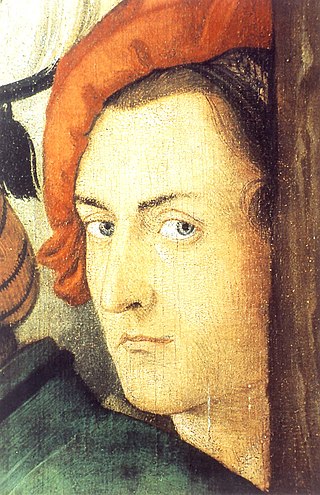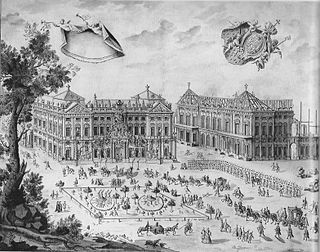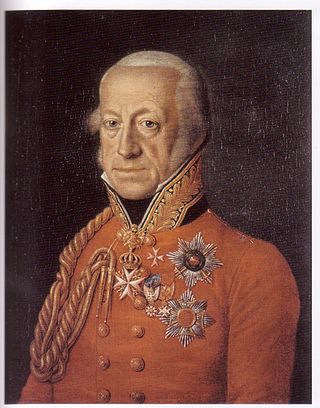
Hans Baldung, called Hans Baldung Grien,, was a painter, printer, engraver, draftsman, and stained glass artist, who was considered the most gifted student of Albrecht Dürer and whose art belongs to both German Renaissance and Mannerism.

Sir James Thornhill was an English painter of historical subjects working in the Italian baroque tradition. He was responsible for some large-scale schemes of murals, including the "Painted Hall" at the Royal Hospital, Greenwich, the paintings on the inside of the dome of St Paul's Cathedral, and works at Chatsworth House and Wimpole Hall.

Luca Signorelli was an Italian Renaissance painter from Cortona, in Tuscany, who was noted in particular for his ability as a draftsman and his use of foreshortening. His massive frescos of the Last Judgment (1499–1503) in Orvieto Cathedral are considered his masterpiece.

Paolo Caliari, known as Paolo Veronese, was an Italian Renaissance painter based in Venice, known for extremely large history paintings of religion and mythology, such as The Wedding at Cana (1563) and The Feast in the House of Levi (1573). Included with Titian, a generation older, and Tintoretto, a decade senior, Veronese is one of the "great trio that dominated Venetian painting of the cinquecento" and the Late Renaissance in the 16th century. Known as a supreme colorist, and after an early period with Mannerism, Paolo Veronese developed a naturalist style of painting, influenced by Titian.

Rastatt is a town with a Baroque core, District of Rastatt, Baden-Württemberg, Germany. It is located in the Upper Rhine Plain on the Murg river, 6 km (3.7 mi) above its junction with the Rhine and has a population of around 51,000 (2022). Rastatt was an important place of the War of the Spanish Succession and the Revolutions of 1848 in the German states.

Corrado Giaquinto was an Italian Rococo painter.

Leopold succeeded in 1830 as the Grand Duke of Baden, reigning until his death in 1852.

Residenz is a German word for "domicile", now obsolete except in the formal sense of an official residence. A related term, Residenzstadt, denotes a city where a sovereign ruler resided, and thus carries a similar meaning to the contemporary expressions seat of government or capital. As there were many sovereign rulers in the Holy Roman Empire, ranking from lord (Herr) to prince elector and king, there are many cities, palaces, and castles in the empire's former territory which used to be a Residenz, some of which are still so referred to today. The former status of a city as a Residenz is frequently reflected in the architecture of its center. During the baroque period especially, many prestigious buildings were erected; sometimes even new towns were founded. Most former Residenzstädte still serve as cultural and administrative centers today.

Sibylle of Saxe-Lauenburg was Margravine of Baden-Baden. Born a Duchess of Saxe-Lauenburg, she was the wife of Louis William, Margrave of Baden-Baden, a famous Imperial general who was known as the Türkenlouis. She was the consort of the ruler of Baden-Baden (1690–1707) and later regent (1707–1727) for her son Louis George. Her older sister Anna Maria Franziska of Saxe-Lauenburg was the future Grand Duchess of Tuscany as the wife of Gian Gastone de' Medici.

Franz Anton Maulbertsch was an Austrian painter and engraver, one of the most renowned exponents of Rococo painting in the German and Hungarian regions.

Luise Adolpha Le Beau was a German composer of classical music. She studied with noted musicians Clara Schumann and Franz Lachner, but her primary instructor was Josef Gabriel Rheinberger. Like many other 19th century female composers, Le Beau began her career in music as a pianist, and later earned her living teaching, critiquing, and performing music.

Johann Jakob Zeiller was an Austrian painter.

The Staatliche Kunsthalle is an fine art museum in Karlsruhe, Germany. Its collection consists of works by mainly German, French, Flemish and Dutch masters from the past eight centuries. The museum was conceived in the early 19th century by Heinrich Hübsch as a “Gesamtkunstwerk” combining architecture, painting and sculpture to house the collection of the Grand Duke of Baden.
Claudio Francesco Beaumont was an Italian painter, active in a late baroque-style mostly in the Piedmont region.

Franz Graf zu Erbach-Erbach was a German nobleman and art collector.
Bad Rotenfels is a district in the city of Gaggenau, district of Rastatt, in Baden-Württemberg, Germany. It is located some 8 km northeast of Baden-Baden.

Kurt Martin was a German art historian. His career began in 1927 as curator of the Baden State Museum Karlsruhe. From 1934 to 1956, he was director of the Staatlichen Kunsthalle Karlsruhe. In 1940 he was appointed Head of the Municipal Museums of Strasbourg as well as Chief Commissioner of the Alsatian Museums. In 1956 he became Director of the Karlsruher Kunstakademie, and in 1957 General Director of the Bayerischen Staatsgemäldesammlungen. He was also a professor of art history.
Karl Joseph Obser was a German archivist and historian, largely known for his studies on the history of Baden during the 18th and early 19th century.

The Master of the Karlsruhe Passion is the notname of a German painter of the late Gothic period active in the Upper Rhine. Very influential on other painters in the region, he may be identified with the Strasbourg painter Hans Hirtz. He is named after his main work, the Karlsruhe Passion, though he may also have been the artist behind the murals in the former Dominican church in Strasbourg, only known through two 17th century copies.

Ignaz Lengelacher was a German-born Baroque sculptor; primarily active in south Moravia.



















